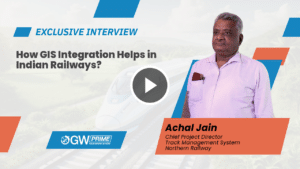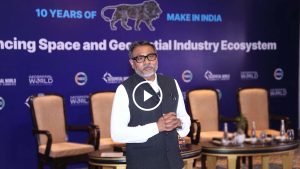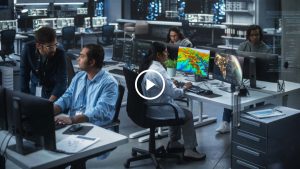“The access to archival satellite data, combined with current agricultural season data can help cultivators gain insights into the crop condition in different areas, and stages of crop growth, allowing them to plan resources accordingly”, says Prateep Basu, CEO, SatSure, in an exclusive interview with Geospatial World.
What do you think is the role of EO and satellite imagery data in agriculture today?
Globally, the adoption of EO satellite imagery has increased. This is not just in specific sectors but across the agricultural value chain like credit lending, insurance, input and machinery, agriculture co-operatives, commodity markets, production companies and market linkage players.
In the context of India, initiatives like Digital India, AI in agriculture and, industrial revolution 4.0 are driving the adoption of satellite imagery-based analytics.
As a fallout of pandemic supply chain disruptions and the Russia-Ukraine conflict, millions of people globally are at a risk of starvation as per the UN. How can we best leverage EO, analytics and AI to avoid similar scenarios?
Geospatial plays a crucial role in global supply chain disruption scenarios, providing transparency and insights into what is happening in a particular location without the need of any physical visits.
Infact, we saw an increased awareness and interest regarding remote assessment using satellite imagery during COVID-19, especially in the financial sector. We have two unique scenarios which prove the importance of geospatial analytics during crisis.
Scenario 1: During the 2018 Kerala Floods, the Government of Kerala used geospatial technology for evacuation planning and mitigating strategy for limiting the loss of life and property.
SatSure worked along with IBM to deliver a platform which combined diverse datasets like emergency call locations, current and estimated flooding intensity, digital elevation models for slope analysis and rainfall data to create risk zones. The Government of Kerala was able to evacuate more than 12,000 people using a portal.
Scenario 2: The advent of COVID-19, around March 2022 saw a massive supply chain disruption in agriculture. Due to restrictions on movements and lockdowns farmers and traders had a hard time buying and selling the commodities. We built a public portal with details of warehouses, cold storage facilities and logistic providers and invited buyers and traders to engage on the platform which helped farmers and traders from different parts of India engage and trade.
Thus, it is very clear, if used with the right intent, EO data analytics can play a constructive role in helping people, communities and organizations, public or private, tackle situations of crisis.
Governments need to play an active role in digitization of processes and datasets like land record data, farm boundaries etc. and open it up with good data governance models, for accelerated adoption and technological innovation driven by the growing startup ecosystem
How to make agro-business more resilient to vagaries of extreme weather and other uncertainties, and what role can EO, data analytics and new technologies play in it?
Companies engaged in the agricultural value chain need to understand the threat of climate change and act to build resilient models for themselves and the ecosystem if they want to mitigate the risks associated with it.
This starts with the basics of understanding the role EO data and educating the teams and ecosystem about it. This has to be a collaborative approach. The technology is still new in many parts of the world, especially in developing countries which are have a poor digital infrastructure. The demand for food is going to increase, 9.7 billion people by 2050 will need to be fed.
Thus, to tackle this growth in demand, organizations involved in agriculture have to be future ready, and the first step towards this is digital transformation, of data and processes. Governments need to play an active role in digitization of processes and datasets like land record data, farm boundaries etc. and open it up with good data governance models, for accelerated adoption and technological innovation driven by the growing startup ecosystem.
Geospatial data will play a critical role in enabling access to data and information and create a decision making model which shall be backed by scientifically derived information, instead of the current, physical survey based model which is not scalable, highly prone to errors and lacks transparency.
How can satellite data empower cultivators and what can governments do to promote its use?
Government is the most important enabler for digital transformation in agriculture, because globally, the agriculture and land data is managed by it. Additionally, the data infrastructure and decisions on production, distribution and pricing is taken care of by the government bodies in most developing countries.
Thus, without an active participation of governments, any large scale implementation and adoption is not possible in the area of agriculture. Like highlighted previously, satellite imagery based analytics can help cultivators gain transparency throughout the crop growth stages.
Additionally, the access to archival satellite data, combined with current agricultural season data can help cultivators insights into the crop condition in different areas, stages of crop growth and plan the resources accordingly.
In a pre-harvest scenario, this means providing the right resources at the right time for a good production and controlling damage due to a natural event. While in a post harvest scenario, it boils down to better decision making on harvesting intervals, storage planning, market arrivals and a seamless distribution supply chain.
What is your view on food security?
To meet the global food demands, which will increase by 70% by 2050 to feed more than 9 billion people, food security is and will be one of the major objectives of countries globally.
The green revolution post-independence in India helped pull India out of food production crisis and made the country not just self-sufficient, but also one of the largest producers of major commodities in the world. This happened due to adoption of technology.
With the growing population, today, food production may not be a major concern for many countries. However, its efficient distribution is what will define that every person gets access to quality food. This is where technology now has to play a pivotal role.
Another aspect is the threat of climate change which will reduce the production capacities globally. It is very important to adopt sustainable agricultural practices for optimum use of resources using advanced technology to create a climate resilient mode for tackling food security.








